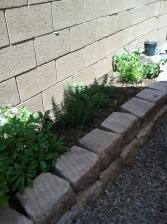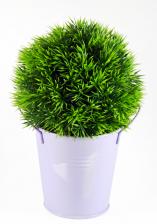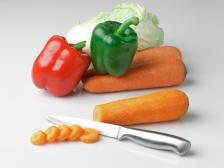How to Make a Vegetable Garden in a Small Space
Want to have a garden, but short on space? Here are a few steps to help you decide which type of small space gardening is for you and get on your way to growing your own vegetables and herbs.
Quite often when we think of vegetable gardening, we think of a huge 50 x 50 plot of ground that gets tilled, raked, and fenced off; a piece of land that will eventually reap bushels of vegetables that require canning or freezing.
This is great if you’ve got the space but for many of us, that’s just not an option. City dwellers who have small yards or patios are not exempt from enjoying homegrown vegetables and herbs.
With a little ingenuity, you can make this a reality. When you enjoy your first homegrown tomato with a little fresh basil from your herb garden, not only will you burst with pride at growing your own sustenance, but your body will thank you for feeding it something fresh and homegrown.
To help you get started on your gardening adventure, here are a few steps to help you decide which type of small space gardening is for you:
Pick Your Planters

Raised Bed Garden – If you do have a yard but don’t want to do any digging or tilling, raised beds are a good option. There are many ways to build a raised bed garden using all sorts of different materials. Decide what your budget is and then visit your local home and garden center. If you are handy with tools, you may want to build a raised bed. Sunset.com has some easy-to-follow instructions on how to do just that.
If that sounds too difficult, you may want to try your hand at setting up a 3-season garden bed using garden block. HomeDepot.com has step-by-step instructions on how to do that.
If that still seems too daunting, you can order a raised-bed garden kit that comes with everything you need to quickly set up your garden area.
Container Garden – If raised-bed gardening seems like too much of a commitment or you simply don’t have that kind of space to work with, container gardening may be the way to go. With this type of gardening you are not only growing your vegetables, but you can use your containers as patio décor as well. There are many different styles and materials to choose from when it comes to pots.
Your container selection will depend on the types of vegetables you decide to grow. Vegetables with shallow roots like lettuce, radishes, and herbs can grow in as little as 8-inches of soil depth. More productive plants, such as tomatoes, bush beans, and squash, need deeper and larger pots. You will also want to choose the material the pot is made of by following a few basic principles.
If you are in a dry climate, terra cotta pots are a good choice since they retain moisture a little better than plastic or metal. There are some beautiful large ceramic pots to choose from, but if you’ve got to lug that pot all the way up to your third floor apartment balcony, you may want to think again.
Vertical Garden – Finally, if you are really short on space or if you want to use your garden as wall decoration, you may want to add some vertical gardens to your space. These can be made using many recycled items like pallets, gutters, coffee cans, and even hanging shoe bags. I have a bunch of examples of these on my Pinterest Gardening board, so pop over there to get some inspiration!
Prepare Your Planters

Make sure the containers you choose have adequate drainage holes. If there aren’t any, drill a few holes in the bottom of the pot before adding soil. When I am getting a container ready for a planting, I always use a few paper coffee filters to cover the holes at the bottom. This ensures that no soil will leak out of the bottom when the pot is moved or the plants get watered. You can also put a shallow layer of gravel on the bottom of the pot before adding soil.
Prepare Your Dirt
If you’re preparing a raised bed garden, ask your local nursery for help on choosing the best soil for your geographical area. This is one step on which I would definitely consult the professionals in your area. The right soil will make all the difference in how productive your garden is, so make sure you talk with someone who knows what your regional needs are based on your climate and soil.
For example, you probably wouldn’t think of lush vegetable gardens in the Arizona desert (where I live), but with the right soil and nutrients, it is possible to grow amazing gardens here!
Container and vertical gardens are also picky with the type of soil they use. When choosing a potting mix for container gardening, go for a mix made specifically for container gardening to ensure that plants will have healthy roots. A good certified organic mix is Nature Mix Container Soil. Again, ask at your local nursery for direction in choosing the right base.
Choose Your Foods
Choosing which vegetables you will plant will depend on a few factors.

If you’re unsure, The National Gardening Association has a helpful website to help guide you. Remember, if you are a beginner, start with just a few varieties of vegetables. It’s easier to learn about a few varieties and how to plant, water, fertilize, and harvest them rather than trying to manage 10 different vegetables all at once. You can always go bigger down the road.
Follow the planting guide for your seeds and plants found on the packaging. The information on the package will also give you a rough estimate of how often to water and fertilize, and how long until your vegetables can be harvested.
Water and Feed Your Food
How often to water and fertilize can vary greatly on what part of the country you live in, if your plants are in raised beds or containers, and what vegetables you have planted. This may take a small amount of research on your part. Fertilizing will also be something to research. I strongly recommend using only organic fertilizer. You’ll be surprised just how easy that is to do. MotherEarthNews.com has awesome advice on exactly how to fertilize organically.
Harvest and Enjoy

If you’ve got children, be sure to get them involved in your vegetable growing venture. Give them the responsibility for checking their plants every day, as well as watering and fertilizing. If it’s summer and your kids needs something to do, let them keep growth charts tracking the progress of the vegetables. They will end up having a more vested interest in the vegetables which in turn might make them more excited about eating them!
Do you enjoy gardening in small spaces? Tweet me your container garden pictures @thedomesticceo and we can share ideas!
Until next time, I’m the Domestic CEO, helping you love your home.
Vegetable garden and other images courtesy of Shutterstock.





